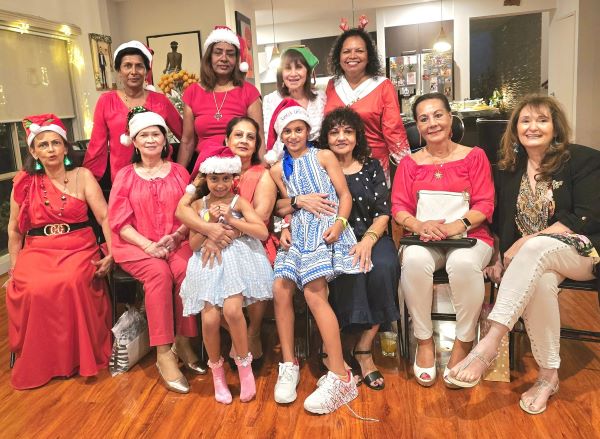The Murals at Gotami Viharaya-by Uditha Devapriya
Source:Dailynews
Commissioned in 1939 and completed a year later, the murals at Gotami Viharaya in Borella were painted at a time of conflict and world war. Representing a high point of Buddhist temple art in the 20th century, they occupy a world away from the art décor, art nouveau, and rococo styles that had come to prevail in Buddhist temples. They borrow from the past, yet subvert its tropes. They are rooted in tradition, yet are also modernist.
The Viharaya was constructed in 1925 on land owned by Lady Apollonia de Soysa. The mother of Sir James Peiris, Lady de Soysa belonged to the colonial elite in British Ceylon. By inheritance and marriage, her family was connected to some of the most important figures in 20th century Sri Lanka, who played a major role in the country’s culture. Lady de Soysa’s grandson, Harold Peiris, devoted much of his life to the cultural revival of the 20th century. His cousin Harry Pieris went on to become a leading national painter.
It was against this backdrop that Peiris persuaded his brother-in-law George Keyt to paint the murals at the Gotami Viharaya. Keyt did not accept a payment for the commission, though his benefactors provided him with the material: one report indicates the paint alone cost Rs 35,000, a huge sum back then.
Middle-class inheritance
By now, George Keyt had fully abandoned his Anglican upbringing. Renouncing his middle-class inheritance, he had first attempted to enter the path of a Buddhist monk. He then began contributing to arguably the most seminal Buddhist publication in the country, The Buddhist Annual of Ceylon. Over the next few years, he drew sketches from the life of the Buddha, the Jataka Stories, and classical Sinhala texts for other publications, including the Ceylon Daily News Vesak Number and Observer Annual.
In her book Buddha to Krishna: Life and Times of George Keyt, Yashodhara Dalmia contends that in all this, Keyt was shaped by the growing tide of Buddhist nationalism.
This is a fairly accurate observation. But it reduces Keyt to a passive receptacle, a byproduct of various external developments. Keyt’s response to the Buddhist revival was radical, for it represented an affirmation of an ancient tradition. Yet, at the same time, as Dalmia notes, he did not let the revivalism of his time dictate his conception of art. The sketches he drew for The Buddhist Annual, which predict his paintings for the Gotami Viharaya, are at one level respectful of the characters they portray. Yet, they are also bold and innovative. The painter regards his subjects with justifiable awe, but does not deify them.
Keyt’s sketches in the 1920s and 1930s are somewhat evocative of the figures of the British painter and sculptor Eric Gill. By the late 1930s, however, he has grown fascinated with the curve, a hallmark of traditional Sinhalese painting. Most of his sketches from this period, featured in publications like the Daily News Vesak Number and the Observer Annual, are well-rounded and well-curved. These bring out a quality of sensuousness. This is especially so of his female figures. One sketch, of Mahamaya Devi sleeping on her bed, stands out in particular. Languid and relaxed, she is well poised even at rest. Though only a sketch, we can almost imagine the colour of her flesh, the thoughts on her mind.
Notes that Keyt did not come up with preliminary sketches of the murals at the Gotami Viharaya. This may be because he had done them many times before, elsewhere. The sketch of Mahamaya Devi resting peacefully, for instance, predicts his portrait of her in the temple. Such parallels underlie a sustained evolution in his career.
For these reasons, we cannot comment on the Gotami Viharaya murals in isolation. They must be placed in their context. From the soft, languid figures of Siddhartha, his wife Yasodhara, and his disciples and associates, to the writhing, contorted figures of Mara and his army, Keyt exhibits a grasp of multiple styles.
More than anything, one notices an attempt at humanising his characters. Unlike traditional Kandyan temple art, the murals at Gotami Viharaya are lifelike, certainly life-sized. Yet they are hardly larger than life. In this regard, Keyt chose not to include the suvisivivarana and sathsatiya, episodes that follow the Buddha’s attainment of Enlightenment. They may have been too evocative of the supernatural for him.
Code and logic
By contrast, Keyt dehumanises Mara and his army. They are made to stand apart from the rest, and we are made to see them as such. They are the “Other”, and as such exist away and apart from the code and logic undergirding his other panels.
When first shown the outlines of the murals, we are told the monks at the Viharaya raised concerns over their depiction of female sensuality. Unlike most murals, Keyt had chosen not to feature fair-skinned women in his panels: almost all of them are brown-skinned. At one level, that represents an attempt to de-exoticise the South Asian woman, something Dalmia emphasises in her book. Yet at another level, it betrays his fantasies and obsessions about that specific type of woman: in all these paintings, Keyt probably recalled his wife, Pilawela Menike, who occupied his life and dominated his passions.
In other words, in a pattern reminiscent of most of the other members of the 43 Group, Keyt’s radical conception of art was tempered by a somewhat conservative counterpoint, be it in his choice of colour or his mode of representation.
Break with tradition
From the perspective of their moment (or the moment of their perspective?), of course, these murals do represent a break with tradition, and they should be discussed, praised, or critiqued in that light. But perhaps owing to their inability to go beyond the visual confines of the medium they worked in, the 43 Group became, as Ismail notes, “complicitous” both with nationalism and, ironic as it may sound, orientalism.
There is nothing overtly orientalist about the murals, of course. Yet, in the female figures which adorn these walls, there is an attempt, however vague or slight, to translate his obsession with dark-skinned women into a definitive form. This, we believe, may explain his reluctance to leave the murals in sketch outline: he knew, and not wrongly, that they would lose their character if not in colour.
Today the Gotami Viharaya stands on the side of a residential road in Borella. Keyt’s murals, on walls designed by the British architect Andrew Boyd, contrast sharply with the buduge, which features murals more in line with conventional 20th century styles.
George Keyt’s contribution to the Buddhist revival, as a writer, a poet, and finally a painter, thus comes out beautifully in these panels. They reflect his abilities, and no doubt also his limitations. Yashodhara Dalmia describes the Viharaya as “perhaps the second most visited monument after Sigiriya.” Yet today, it stands in isolation from its surroundings in Colombo, indeed from the rest of the country. That is a pity, for at the temple, we discern a high point not just in Sri Lankan but also in South Asian and Asian art.


























